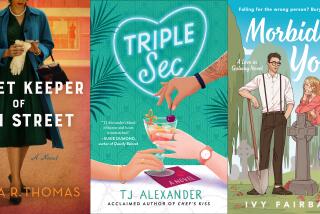Sassy chick lit finds new fans among India’s young women
NEW DELHI, INDIA — Indian bookstores these days are stocking up on a new kind of English-language novel -- the kind in which twentysomething urban women put their careers first, ridicule arranged marriages and wrestle with weight gain.
The internationally trendy fiction genre known as “chick lit,” popularized by “Bridget Jones’s Diary” and “Sex and the City,” now has an Indian avatar.
In a country where marriages are usually arranged by parents in consultation with astrologers and where women are traditionally expected to sacrifice their own aspirations in the interest of family, the cheeky chick-lit heroines are being embraced by readers who see the lighter side of Indian mores.
The plots reveal Indian city-dwellers confronting the amusing vagaries of daily life -- a working woman puts her family astrologer’s number on speed dial on her cell phone; another woman dumps trash on a boy her mother sends for an arranged marriage; a couple’s romance blossoms through a series of sticky notes stuck on a car in a parking lot; a mother bemoans her bad karma because her 29-year-old daughter is still single.
Indian chick lit is the latest and most irreverent entrant into the world of English-language fiction here. But publishers and critics say it is also a reflection of the growing confidence among women in Delhi, Kolkata, Mumbai and elsewhere.
“This is the story of the new Indian woman in the cities. She is single, has a career and is willing to have fun, take risks and find a man her way, and not necessarily her family’s way. It is a woman we have only read about in books from the Western countries and now, suddenly we are finding her on Indian roads,” said V.K. Karthika, the publisher and chief editor at Harper Collins India, who launched “Almost Single” by debutante writer Advaita Kala. The book has sold 10,000 copies in the past four months and is now in its fourth printing, a huge success by the standards of English-language fiction in India.
In the past five years, a handful of novels geared toward young women, including “Girl Alone” and “Piece of Cake,” have drawn a following in India. But the success of “Almost Single” has revealed the larger, untapped market for a girls-having-fun genre.
“A generation ago, marriage was the only route to independence from parental control in India. Now women are working, living alone in the cities, hanging out with women friends, drinking, dating and having fun in spite of the enormous social pressure to get married,” said Kala, 30, the witty author of “Almost Single.”
“They inhabit a world where women enjoying a drink in the bar are not social outcasts. They are not tragic figures because they are single.”
Kala, who has a liberal arts degree from Berry College in Georgia and works as a job trainer for the Taj group of hotels in India, says the protagonist in her novel is witty, outspoken and comfortable with her single status. She will not be forced into an arranged marriage with someone she sees as incompatible.
The heroines of chick lit skillfully balance cultural traditions with 21st-century lifestyles, trying to observe fasting rituals while adhering to the Atkins or South Beach diet, choosing to hang out with gay friends or facing a mother’s disapproval.
“I like such books because they resemble my life and the conversations I have with my friends and parents,” said Jyoti Trehan, a 25-year-old advertising executive who was browsing a New Delhi bookstore on a recent day. “We have the baggage of culture imposed on us. We have to be a good daughter, be chaste, marry at the right age, be a good wife and a good daughter-in-law. But all we want is to have fun like everybody else.”
Kala’s protagonist works in a five-star hotel, smokes and drinks, can “name old and new wines with great elan, and can tell my cheeses apart.” She turns to her two friends with problems involving her nagging boss or her mother, who gives her “umbilical cord whiplash,” phoning with the names of candidates for an arranged marriage.
One of the men her mother presents is an Indian who works for McKinsey & Co. in New York. He is a conservative Hindu vegetarian who has one condition for a bride: She must not eat garlic and onions. Kala’s heroine, Aisha, wonders if she should develop her own set of dietary demands for a prospective groom. “No problem, Ma, just make sure he is on high proteins and no carbs,” she says.
The mother chides her for showing disrespect to other people’s traditions, and Aisha fears she might be missing out on the nuances of ancient culture in her “desire to be a liberated Indian woman.”
The cover of Kala’s book features a woman in a red sari, the traditional Indian garment for women, and red Reebok sneakers. The sari, in fact, is often treated as a metaphor for the traditions that weigh so heavily on the heroines of chick lit. At one point in Kala’s book, Aisha wears jeans under her sari.
During a shopping expedition in the novel “Piece of Cake,” the protagonist does her best “to drape the six-yard length of fabric, and emerged holding up the various folds that keep getting tangled in my feet.” She calls the sari the “strangling folds.”
Many Indian women live in worlds that bear no resemblance to those in chick-lit novels. Nearly two-thirds of the population still live in rural areas, where girls grow up in families that provide many opportunities to boys but none to girls.
“I am keenly aware that my book represents a sliver of Indian society, but it is a growing sliver,” said Kala, who said she learned what it was to be poor during her student years in the United States, when she cleaned dorm toilets and had to choose between a meal and a large Pepsi.
Now, Kala is single and lives with her parents in New Delhi. She wears a ruby ring that her family astrologer recommended for creativity. She said he predicted her book’s success and forecasts that she will get married “very soon.”
Kala’s publisher said that although Bollywood movie plots and television soaps continue to dish out regressive roles for women, post-feminist chick-lit heroines are showing up in the Indian editions of magazines like Vogue, Cosmopolitan, Elle and Marie Claire. Building on the success of “Almost Single,” Vogue invited Kala to write a column. The Hindustan Times newspaper in New Delhi runs a weekly column called “Single in the City” by a female writer.
Recently, a group of 40 Mary Kay representatives from the United States were presented with copies of Kala’s book while staying in a New Delhi hotel. One of the women, Jennifer Isenhart of Wilmington, N.C., said she enjoyed the book so much that she contacted Kala and asked her to sign 25 copies so that she could take them to friends back home.
“The book showed me that young women are the same everywhere. They have the same problems of boyfriends and bosses. They drink coffee, love to shop and have fun,” said Isenhart, 28. “To enjoy life is empowerment, too.”
More to Read
Sign up for our Book Club newsletter
Get the latest news, events and more from the Los Angeles Times Book Club, and help us get L.A. reading and talking.
You may occasionally receive promotional content from the Los Angeles Times.









